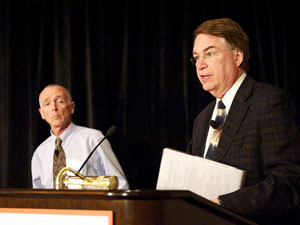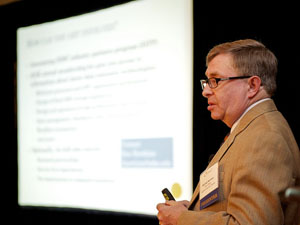La Jolla Research & Innovation Summit, Part One: Dealing with the Data Deluge
By Tiffany Fox, (858) 246-0353, tfox@ucsd.edu
San Diego, Calif., April 25, 2011 — Core assets. Emergent technologies. Unprecedented opportunities.
Such phrases turned up again and again at the third annual La Jolla Research and Innovation Summit on April 21, as top research scientists from the University of California, San Diego and other local institutions met with venture capitalists to discuss the future of cleantech, biotech, wireless and information technologies.
|
The half-day, invitation-only summit was held at the Estancia La Jolla Hotel & Spa and was hosted by CONNECT, a regional program that links inventors and entrepreneurs with the resources they need to commercialize their products by promoting collaborations between industry, venture capital sources and research organizations. UC San Diego was well-represented at the event, with faculty from eight academic departments and several UCSD-affiliated research institutions moderating panels or delivering presentations on some of the university’s most influential and collaborative research.
In his opening remarks, CONNECT CEO Duane Roth noted that there are more than 80 research institutes within a mile of one another on La Jolla’s Torrey Pines Mesa.
“That connectivity is what makes this region particularly interesting,” added Roth. “The people who come to La Jolla to develop these institutes are not leaving. The problem is, there are a lot more great ideas here than there is venture capital.”
In addition to a keynote on the future of wireless health car by Eric Topol, MD, of The Scripps Research Institute, the summit agenda focused on five well-funded areas of research currently underway in La Jolla and San Diego. Calit2 Director Larry Smarr moderated a plenary session on the exponential ‘data deluge’ caused by output from digital health sensors, scientific instruments and parallel computers. He cited the Large Hadron Collider, which produces massive amounts of data, but incorporates both private fiber optic cable links and existing high-speed portions of the Internet, enabling data transfer to academic institutions around the world. Smarr and his colleagues at Calit2 are on the forefront of research to harness the power of optical networks to share similarly massive amounts of data at even faster speeds.
Added Smarr: “I think you’re going to see in La Jolla some of the first examples of people starting to tame these large amounts of data and using them just as you would the Internet.”
One such person is UCSD School of Medicine Chief of Genetics Trey Ideker, who, along with his colleagues at the Moores UCSD Cancer Center, is assembling large maps of the molecular networks underlying cancer to aid diagnostics and drug discovery. During his talk, Ideker predicted that the cost for sequencing an individual’s genome will soon equal the price of a simple blood test.
“This multiscalar, modular view of life will need to be captured and put into data systems,” he explained. “Just as a mechanic would look at a wiring diagram to determine how to fix your car, a physician could look at the wiring diagram for a cell to understand how to disable the DNA damage response in a tumor cell without damaging normal cells.”
Panelist Mike Norman, director of the San Diego Supercomputer Center at UCSD, said that the amount of digital data generated just by instruments such as DNA sequencers, cameras, telescopes and magnetic resonance imaging machines is now doubling every 18 months.
“Digital data is advancing at least as fast, and probably faster, than Moore’s Law,” said Norman, referring to the computing hardware belief that the number of transistors which can be placed inexpensively on an integrated circuit doubles approximately every 18 months. “But I/O (input/output) transfer rates are not keeping pace — that is what SDSC’s supercomputers are designed to solve.”
SDSC, a key resource for UCSD researchers as well as the UC system and nationally, will later this year deploy a new data-intensive supercomputer system named Gordon, which will be the first high-performance supercomputer to use large amounts of flash-based solid state drive (SSD) memory. Flash memory is more common in smaller devices such as mobile phones and laptop computers, but unique for supercomputers, which generally use slower-spinning disk technology.
|
Another panelist on the “Data, Data Everywhere” panel was Dr. Kevin Patrick, a professor of family and preventive medicine in the UCSD School of Medicine and director of the Calit2-based Center for Wireless and Population Health Systems. Patrick discussed the opportunities and challenges in measuring the “exposome,” i.e., the measure of all the exposures of an individual in a lifetime and how those relate to disease onset and disease prevention.
Explained Patrick: “Unlike a person’s genome, the exposome changes over one’s lifetime. But there is a tremendous imbalance between what we know in genomics and what we know on the environmental exposure side.”
Patrick called for new research designs, new methods of data fusion and synthesis, a new generation of health data analysts and even new societal norms to take health care from a closed system of “doctor knows best” to an open system of collaboration.
“There’s no question — this train has left the station,” said Patrick. “It’s like William Muholland said on the day water was brought to Los Angeles: ‘There it is. Take it.’”
The invitation-only summit offered venture capitalists and others in the investment industry an opportunity to hear about technologies that will soon be coming out of the R&D pipeline at UC San Diego. But for attendee Thomas Gephart, a venture capitalist with Orange County-based Ventana, taking advantage of the innovative ideas presented at the research summit might be easier said than done.
“The system for financing private enterprise is broken everywhere down the line,” he said at the Summit. “It needs a total overhaul.”
According to Gephart, venture capital funding in the U.S. has decreased from $70 billion in 2000 to $12.3 billion in 2010.
“China, India, Singapore, Taiwan… those are all great success stories that have come from partnering relationships,” he said. “But in the U.S., small investors have been forced out of business because of a separation between research and investment banking.”
For real progress to be made in the arenas of cleantech, biotech, wireless and information technologies, Gephart said, there must be “a better partnering relationship between private enterprise and government. It’s up to the Securities and Exchange Commission to improve that.”
Note to Readers: In part two of this special report, to be published on April 26, UCSD faculty panelists at the La Jolla Research & Innovation Summit talk about virtual infrastructure, “green expectations,” biophotonics and stem-cell research.
Media Contacts
Tiffany Fox, (858) 246-0353, tfox@ucsd.edu
Related Links



